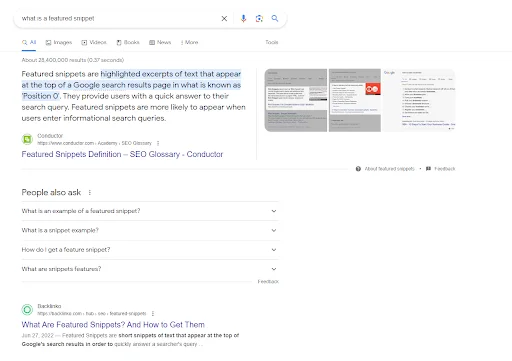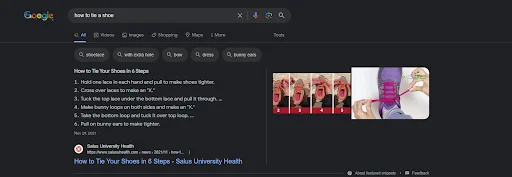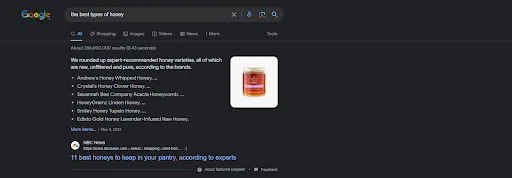Not all search results are made equally. Want to rank for search results that appear before all other organic results? Results so powerful, they’ve been called “Rank #0” results?
You need to start ranking for featured snippets.
Google displays featured snippets before all other organic results—which leads to a lot of trust, a high click-through rate, and many new opportunities. This guide will teach you exactly how to rank for featured snippets. Let’s jump right in:
What Is a Featured Snippet?
Featured snippets are a type of search result offered by Google; they appear before all other organic search results. They offer short, informative answers to queries, which most commonly appear when users search for information (rather than searching for products to purchase).
Here’s what a featured snippet looks like:


That top result—the one that appears before “People Also Ask”—is a featured snippet. Note that it contains a lot more text than the results that follow it, as well as images. This makes it a more attractive search result—featured snippets tend to get a lot of clicks.
According to Search Engine Watch, featured snippets get an astonishing 35.1% of clicks—well worth fighting for in most cases.
The Four Types of Featured Snippets
To target featured snippets, you’ll need to find what content is currently ranking as a featured snippet for a particular keyword and then duplicate the form of that content. There are four different forms of featured snippets:
Paragraph
Paragraphs are the most common type of featured snippet, offering a brief paragraph of text to answer a question. They account for 82% of featured snippets, according to Search Engine Watch (Search Engine Journal, meanwhile, puts that number at around 70%). They look like this:’


This featured snippet is particularly revealing because, in the Search Engine Watch website we linked above, you’ll note that featured snippets actually get 35.1% of clicks. Featured snippets aren’t always accurate (the problem used to be much worse), but you should always strive to make your featured snippets accurate.
List
List featured snippets are usually given in response to “How-to” questions; they account for somewhere from about 9% to 18% of featured snippets. They look like this:


They can also be in unordered form, like so:


Table
Table featured snippets are rarer still, accounting for about 6% of all featured snippets. They’re generally used when data needs to be structured in a particular way—think government or actuarial data. Here’s an example:


Video
Video feature snippets account for about 5% of all featured snippets; they are, as you can guess, featured snippets that contain videos. Google automatically creates a “suggested clip”—the video will show the “Start of Suggested Clip” and the “End of Suggested Clip” so that you don’t end up searching through the video for the content you need. These featured snippets look like this:


How To Optimize Your Content for Featured Snippets
Step 1: Find Featured Snippets You Want To Target
There are a couple of ways to find featured snippets you want to target. You can:
- Use keyword research tools like Ahrefs or Semrush
- Manually look up keywords yourself to see if they qualify for featured snippets
Keyword research tools are by far the easiest way of finding featured snippet opportunities; the best ones will tell you all of the SERP features a particular keyword qualifies for, including whether or not it qualifies for featured snippets.
As you build a list of keywords and queries with featured snippets you want to rank for, you should build a table. This table should include:
- The keyword you’re trying to get a featured snippet for
- The content that is currently ranking for that featured snippet (include the URL)
- The type of featured snippet (paragraph, list, table, or video)
- The search intent (more on that in the next step)
- An outline of the type of content you’ll want to build
- A picture or excerpt of the featured snippet
- The URL for any existing content you want to modify to rank for the featured snippet
By establishing this table, you can focus your efforts so that you don’t end up building too many pieces of content for similar featured snippets. One piece of content can rank for several featured snippets. By organizing your content properly, you’ll avoid redundancy and cannibalization, all while ranking for the featured snippets you’re targeting.
Step 2: Consider Whether or Not the Featured Snippet Is Worth Targeting
Featured snippet opportunities are mostly found for informational queries. A user’s search query can have four different intents:
- Navigational
- Commercial
- Transactional
- Informational
Informational intents tend to be “top of funnel”—users are less likely to make a purchase right away after searching for an informational keyword.
There are still plenty of good reasons to target informational keywords: Brand awareness, product awareness, reputation, and passing link juice to your more valuable pages. Featured snippets are well worth targeting, but not in the abstract—think about how the snippet you’re targeting works into your overall strategy.
You should also consider the type of query the featured snippet is answering—and the length and content of the snippet itself. There has been a rise in what is known as “zero-click searches”—searches where the searcher doesn’t click on any results because the results themselves provide the answer. Featured snippets are a big reason for zero-click searches.
Generally, you shouldn’t focus on featured snippets where a brief answer is all that’s required. Questions like “What country makes cheddar cheese?” only require a simple answer and don’t tend to lead to a high click-through rate (CTR).


Instead, focus on featured snippets that tend to lead to more questions. When users want more information on a topic after receiving an answer to their query, they’ll be more likely to click on a featured snippet.
When you’ve started to rank for a number of featured snippets, you can begin to analyze your CTRs for those snippets. This will give you a better understanding of which snippets lead to clicks for your niche.
Step 3: Analyze the Content That Is Currently Claiming the Featured Snippet
Ranking for any type of featured snippet takes effort. Google doesn’t just look at the text of the snippet itself; it looks at all of the content surrounding the snippet.
Want to outrank your competitors? Your best bet is to research the content that’s ranking for featured snippets—then duplicate their efforts (but better).
Start by looking at where the featured snippet is found in their content. Some useful guiding questions include:
- Is the featured snippet found in an FAQ?
- What are the headings the snippet is found under?
- What is written in the paragraphs before and after the snippet?
- What is the title of the content in which the featured snippet is found?
The types of featured snippets you’re targeting matter, too—you’ll always want your featured snippet to match the type of featured snippet that’s currently ranking. For example, you’ll want a table snippet if that’s what is ranking for a query, and you’ll want a video snippet if a video is currently ranking in the featured snippet spots.
The goal of Google’s search results is to provide users with the best possible answer to the user’s query—whether that be a quick answer or a detailed video. Matching what Google is already providing makes it more likely that you’ll rank for that snippet.
Of course, your goal isn’t to exactly match your competitor; that would be plagiarism. Instead, you’re going to outdo them.
Step 4: Create Content To Outperform Your Competitors
Now that you’ve created a list of featured snippets you want to target and done your competitor analysis, it’s time to build content to outperform those competitors in the search results.
There are a few ways of outperforming your competitors:
- Create content that’s more detailed than theirs
- Increase your click-through rate with catchy titles and meta descriptions
- Use structured data to help Google understand your content
- Answer questions that your competitors aren’t answering
- Include optimized images in your articles
You can do all of the above while keeping the content designed to rank for a featured snippet within about the same context as your competitors did. In other words, make the rest of your content different while keeping the parts of your content designed to rank for featured snippets similar to what your competitors are already ranking for.
Step 5: Track Your Results
Tracking which of your pages rank for Google’s featured snippets can be difficult if you’re only using Google Search Console and Google Analytics. You could go the manual route, but if there’s one cardinal rule in SEO, it’s never to do manually what you can do automatically.
We recommend using an all-in-one SEO platform like Ahrefs or Semrush to track the success of your featured snippet campaign. These tools will tell you which of your pages are ranking as featured snippets for different queries—very helpful. You can then use these tools, coupled with Google Search Console, to see the click-through rate for your featured snippets.
Tips for Landing Featured Snippets
Use negative search operators to improve your snippet research
The featured snippet you see isn’t the only featured snippet that Google has considered. You can use the negative search operator (-) to learn more about the kinds of snippets Google has considered for the featured spot.
First, search the keyword that you want to land a featured snippet for. From there, find the domain that is ranking for the featured snippet. After that, you can use the negative search operator and include -example.com in order to see the second site in line for a featured snippet.
Here’s how it looks:
We want to land a featured snippet for what pancakes are made of:


We see that Wikipedia is the site that’s landing the featured snippet, so we look up “what are pancakes made of -wikipedia.org”. This gives us a new featured snippet:


If we wanted, we could exclude that domain to find a third featured snippet:


We see that, with those two sites excluded, there are no further featured snippets.
This technique is great to see who your competitors are, and what kinds of content are ranking as featured snippets for a given keyword!
Create Content That Will Rank Well in the Search Results
Great content comes first, and almost all featured snippets come from pages that already rank on the first page of the search results. To rank for a featured snippet, you need to make content that would generate organic traffic even if it didn’t land in the coveted featured snippet spot. That means:
- Using tools like Surfer to help you optimize your content
- Writing unique and uniquely useful content
- Having a robust internal linking structure
- Using structured data to help search engines understand your content
- Using optimized images, title tags, and meta descriptions
- Creating an easy-to-understand, well-organized heading structure
- Earning backlinks to your content
By doing all of the above and optimizing parts of your content for featured snippets, you’ll be more likely to achieve your goal.
Answer a Number of Different Search Queries in a Single Piece of Long-Form Content
Instead of building a different piece of content for each featured snippet, organize yourself well in advance and build one piece of content for several similar featured snippets. This often involves creating a lot of H3s (often under FAQs) that could rank for featured snippets. Many featured snippets come from questions as queries—these typically include:
- Who
- What
- Where
- When
- Why
- How
By structuring your content to answer questions, you’ll also be more likely to rank for “People Also Ask” search results—less valuable than featured snippets but still important.
Don’t Be Afraid To Answer the Same Question Twice
Rephrasing your answer to a question—one that may land you a featured snippet—is useful on two counts: It can help users who didn’t understand the first explanation, and it gives you another shot at the featured snippet. In the same vein, you can answer a question in an FAQ that you answered in the main body of your content; some people want to skip straight to the FAQs, and you’ll get two shots at the featured snippet.
Focus on Your Heading Structure
Google chooses what it considers the most valuable content to rank well on its search engine results pages—one way it determines whether or not content is valuable is by evaluating the heading structure. Your heading should answer questions and guide users logically from a point of little knowledge to a point of expertise.
When targeting featured snippets, you should create content that will provide direct answers to the questions posed in your headings. For this reason, FAQs are a great way of ranking for many featured snippets.
Include How-Tos in Your Content
How-tos are the best way to land a list snippet; be sure to include relevant structured data to tell Google where your list begins and ends. Unstructured lists (those with bullet points instead of numbers) are also possible to rank for, but those are less well served by how-tos.
Include FAQs in Your Content
FAQs are a simple way to answer a lot of the queries that you might land featured snippets for; they’re also a great way of landing in “People Also Ask” search results. As always, be sure to analyze the context the current featured snippet is found within—if it’s not in an FAQ, you may be better off placing the content geared for featured snippets in the main body of your text.
Optimize Further by Using Images and Videos
Videos allow you to rank for video snippets, while optimized images make it more likely that you’ll rank for a paragraph snippet. Image optimization is good practice for all SEO, too, so be sure to include images throughout your content.
Conclusion
Featured snippets can help you rank higher and improve your click-through rate. We recommend starting with long-tail keywords; most featured snippet results come from long-tails anyway. Need help ranking for featured snippets? We’re always here to support you—contact us.


